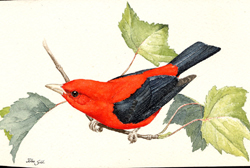Breeding Bird Atlases (BBA)
Find a Bird - BBA1
Breeding Bird Atlas 1 Species Accounts
Scarlet Tanager
Piranga olivacea
Egg Dates
May 24 to June 25
Number of Broods
one

Irrespective of the number of occasions that one watches this species, be it foraging for food high in an oak during the breeding season or in respite from migration in a scrubby coastal thicket, the splendid brilliance of the male Scarlet Tanager is always an awesome sight. Belonging to a large and colorful subfamily of Neotropical birds, the Scarlet Tanager is one of the few species that nest north of Mexico. In Massachusetts, it enjoys a widespread and fairly common breeding status with the exception of much of Cape Cod and the Islands. There, its habitat requirements for mature deciduous or mixed deciduous-coniferous woodlands are either scarce or lacking entirely. Throughout much of the state, mature White Oak-White Pine forests appear to be especially preferred.
Most Scarlet Tanagers arrive in our area in mid-May and reveal their presence perhaps more by songs and calls than by movements, which are characteristically sluggish and purposeful. Paradoxically, the striking coloration of the male seems at times to be well adapted to camouflage, as he disappears suddenly and without effort in the variously deceiving sunlight and shadows at play in the forest canopy.
The arrival of the female in spring evokes the courtship and display response from the male, which generally has established its territory a week or so earlier. In display, the male hops on branches with the wings outstretched, thus exposing his brilliant scarlet back in striking contrast to the jet black of the wings. The song of the Scarlet Tanager, likened to the phrases querit, queer, queery, querit, queer, is a rather hoarse robinlike caroling, which the male sings tirelessly in proclamation of territory, often even at midday, from May until late July or early August. Also heard frequently is a low, distinctive chip-burr call that is given by both sexes throughout the summer.
The nest is a shallow, loosely woven cup of small twigs, grasses, and rootlets lined with finer and softer material, typically being placed in the fork of a branch 15 to 45 feet high and well out toward the periphery of a tree. In Massachusetts, nests have been found in apple, Red Cedar (15 feet), American Beech (15 feet), Red Oak (20 feet and 25 feet), and Sugar Maple (50 feet) (ACB, CNR, Meservey). Nest sites may be in forests, in trees bordering openings such as power-line cuts, in orchards, and in large shade trees about lawns and gardens.
Incubation of the three to five somewhat glossy, light to greenish blue eggs, marked with reddish brown spots or speckles, is accomplished solely by the female. A Worcester County nest contained four eggs on June 14 (DKW). The eggs hatch in 13 to 14 days, and the altricial young leave the nest after another 9 to 11 days (sometimes slightly longer). The young, which resemble the female, are fed, by both parents, a diet of insects. In late summer and during the fall migration, various fruits and berries are also readily ingested. Nest parasitism by cowbirds has been documented.
There is little specific information available about nesting in Massachusetts. Nestlings have been recorded in the state from June 15 to July 2 (CNR, Meservey). A Dartmouth nest contained two young on June 20, and the male was seen feeding one fledgling on June 30 (CNR). One brood is raised each season. Molting is initiated in early to mid-August and continues into September; family groups in varying stages of molt can be seen well into the first half of September. Some migration commences in late August; but the bulk of the migration occurs by mid-October, when the last Scarlet Tanagers have departed for their wintering grounds in the tropical rain forests of South American from Colombia to Bolivia.
Map Legend and Data Summary
Atlas 1 data collected from 1975-1979


Note: fairly common in mature mixed and deciduous woodlands; scarcer on the Cape and Islands
Richard S. Heil



